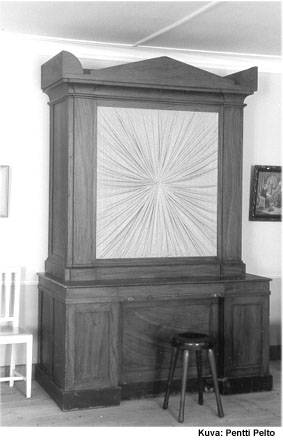
|
HISTORICAL ORGANS IN FINLAND 
Ilmajoki, Yli-Könni- Thulé, Anders 1850
- 4 stops, 1 manual, no pedal
- mechanical action and mechanical stop action
The Ilmajoki Yli-Könni chamber organ has no signature, but a letter from Juho Yli-Könni dated 1907 relates that the instrument was built by Anders Thulé. The technical properties of the organ corroborate this. The year of building is not known, since Anders Thulé only kept sketchy notes of projects that did not involve church organs. The Könni organ is known to have been borrowed for use in Ilmajoki Church at the time when the old Wåhlström organ had already been taken to Raippaluoto Church in 1876 but the new Zachariassen organ (completed in 1878) was not yet finished. The organ is still in possession of the family, and it is to some extent playable. With four stops, it is the largest chamber organ that Anders Thulé ever built. We have scant information on what music was played on the chamber organ. We may surmise that it was used to accompany hymns, spiritual songs and folk songs, and perhaps even to play piano music of the day.
Technical features
The organ case is divided into two sections: the lower section contains all the functional components, while the upper section contains the pipes. The upper section is decorated with pilasters, and a sharply profiled moulding encircles the top. The façade consists of typical radially pleated fabric. The external surface is painted to imitate mahogany.
The Könni organ has a double bellows, with the lower segment functioning as the feeder bellows and the upper as the reservoir. Both are wedge-shaped, and they share the same middle frame. A wind trunk leads from the upper bellows to the pallet box of the chest. The entire bellows system can easily be extracted for maintenance and repair, and to make the instrument lighter for transportation. The pumping pedal can be placed near the organist’s right foot to be worked by him or on the right wall to be worked by an assistant.
The chest is a chromatically organized lamellar slider chest. On the keyboard, the naturals have an ebony veneer with two very narrow mother-of-pearl inlay strips. The sharps have a bone covering. The keyboard is carefully finished, and it has a lid that forms the music stand when opened. The action functions with long, radial backfalls. On either side of the keyboard there are two small unlabelled metal knobs for operating the stops.
Sound
The disposition has two 8’ and two 4’ stops, enabling a variety of combinations. The Flöjt amabile is described as a Principal in some sources.
All the pipes are of wood. Both 8’ stops share the same great octave. The pipes are narrow and rectangular in cross-section, whereas in Anders Thulé’s church organs the wood pipes are square in cross-section. The obvious reason for this is that a pipe with a narrow mouth has a soft sound, appropriate for a home instrument. A square pipe has a strong and active sound because of its relatively wide mouth. There are no pipe racks; instead, the pipe feet are snugly fitted to holes in the upper board.
Disposition
Manual C-f3 |
|
|
Gedacht 8’ | | |
Doppelflöjt 8’ | | |
Flöjt amabile 4’ | | |
Rörflöjt 4’ | | |
| | |
| | |
| | |
| | |
| | |
| | |
| | |
| | |
| | |
Further information
Pelto Pentti, Anders Thulén kamariurut. Organum 3/93.
|